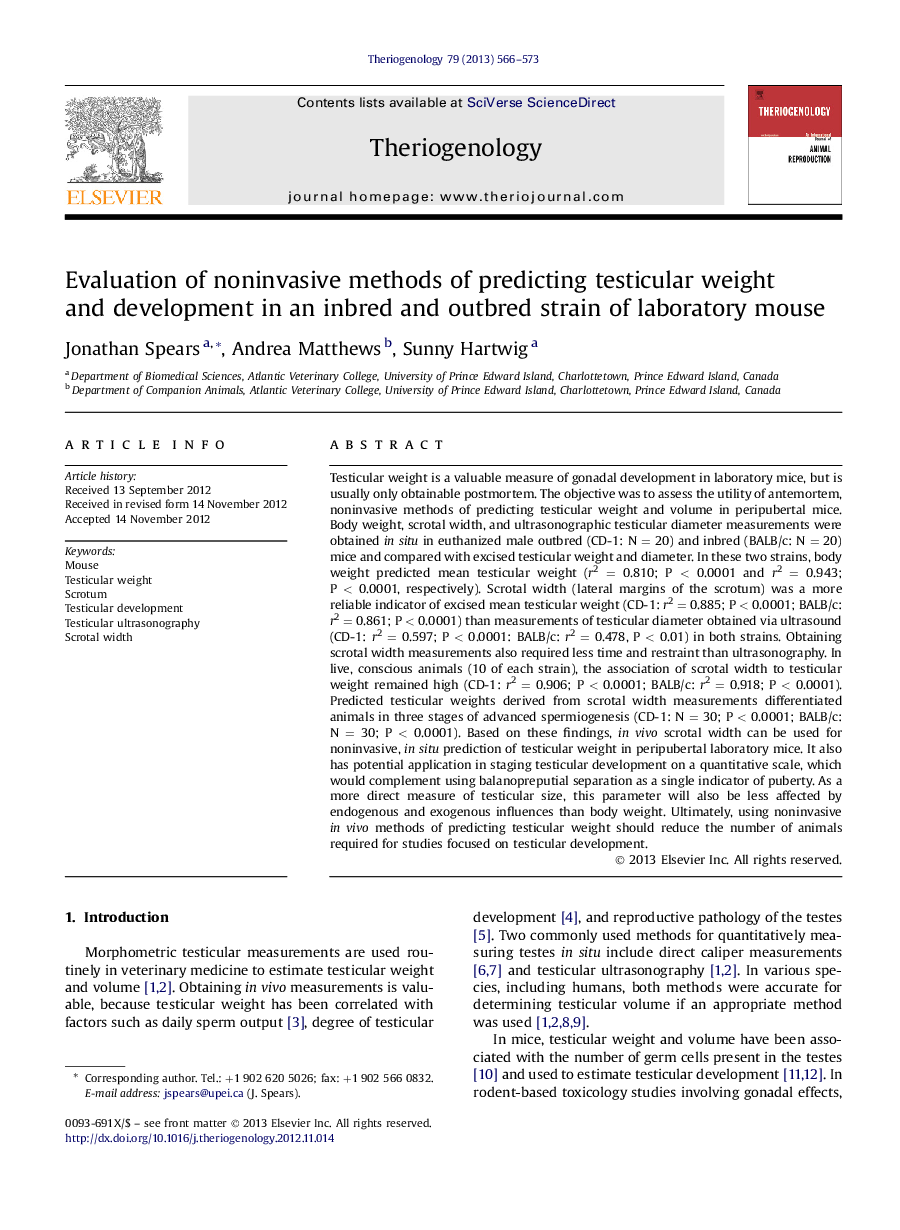| کد مقاله | کد نشریه | سال انتشار | مقاله انگلیسی | نسخه تمام متن |
|---|---|---|---|---|
| 10892106 | 1082088 | 2013 | 8 صفحه PDF | دانلود رایگان |
عنوان انگلیسی مقاله ISI
Evaluation of noninvasive methods of predicting testicular weight and development in an inbred and outbred strain of laboratory mouse
دانلود مقاله + سفارش ترجمه
دانلود مقاله ISI انگلیسی
رایگان برای ایرانیان
موضوعات مرتبط
علوم زیستی و بیوفناوری
علوم کشاورزی و بیولوژیک
علوم دامی و جانورشناسی
پیش نمایش صفحه اول مقاله

چکیده انگلیسی
Testicular weight is a valuable measure of gonadal development in laboratory mice, but is usually only obtainable postmortem. The objective was to assess the utility of antemortem, noninvasive methods of predicting testicular weight and volume in peripubertal mice. Body weight, scrotal width, and ultrasonographic testicular diameter measurements were obtained in situ in euthanized male outbred (CD-1: N = 20) and inbred (BALB/c: N = 20) mice and compared with excised testicular weight and diameter. In these two strains, body weight predicted mean testicular weight (r2 = 0.810; P < 0.0001 and r2 = 0.943; P < 0.0001, respectively). Scrotal width (lateral margins of the scrotum) was a more reliable indicator of excised mean testicular weight (CD-1: r2 = 0.885; P < 0.0001; BALB/c: r2 = 0.861; P < 0.0001) than measurements of testicular diameter obtained via ultrasound (CD-1: r2 = 0.597; P < 0.0001: BALB/c: r2 = 0.478, P < 0.01) in both strains. Obtaining scrotal width measurements also required less time and restraint than ultrasonography. In live, conscious animals (10 of each strain), the association of scrotal width to testicular weight remained high (CD-1: r2 = 0.906; P < 0.0001; BALB/c: r2 = 0.918; P < 0.0001). Predicted testicular weights derived from scrotal width measurements differentiated animals in three stages of advanced spermiogenesis (CD-1: N = 30; P < 0.0001; BALB/c: N = 30; P < 0.0001). Based on these findings, in vivo scrotal width can be used for noninvasive, in situ prediction of testicular weight in peripubertal laboratory mice. It also has potential application in staging testicular development on a quantitative scale, which would complement using balanopreputial separation as a single indicator of puberty. As a more direct measure of testicular size, this parameter will also be less affected by endogenous and exogenous influences than body weight. Ultimately, using noninvasive in vivo methods of predicting testicular weight should reduce the number of animals required for studies focused on testicular development.
ناشر
Database: Elsevier - ScienceDirect (ساینس دایرکت)
Journal: Theriogenology - Volume 79, Issue 3, February 2013, Pages 566-573
Journal: Theriogenology - Volume 79, Issue 3, February 2013, Pages 566-573
نویسندگان
Jonathan Spears, Andrea Matthews, Sunny Hartwig,